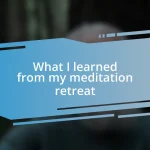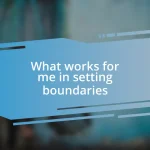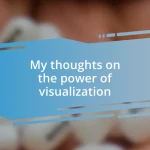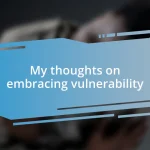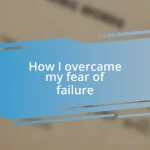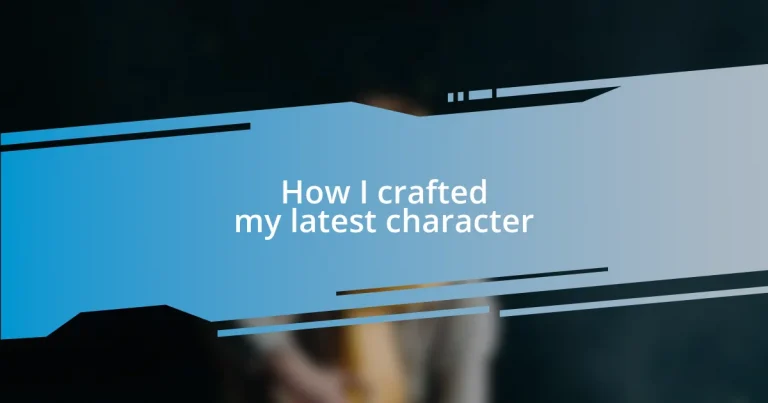Key takeaways:
- Identifying character traits involves observing real-life influences, emotional reactions, and environmental interactions to shape their depth and complexity.
- Developing a backstory adds layers to characters by exploring past experiences, relationships, turning points, and aspirations that inform their motivations and conflicts.
- Creating a personality arc is essential for character growth, often driven by central conflicts, emotional trajectories, and external influences from other characters.
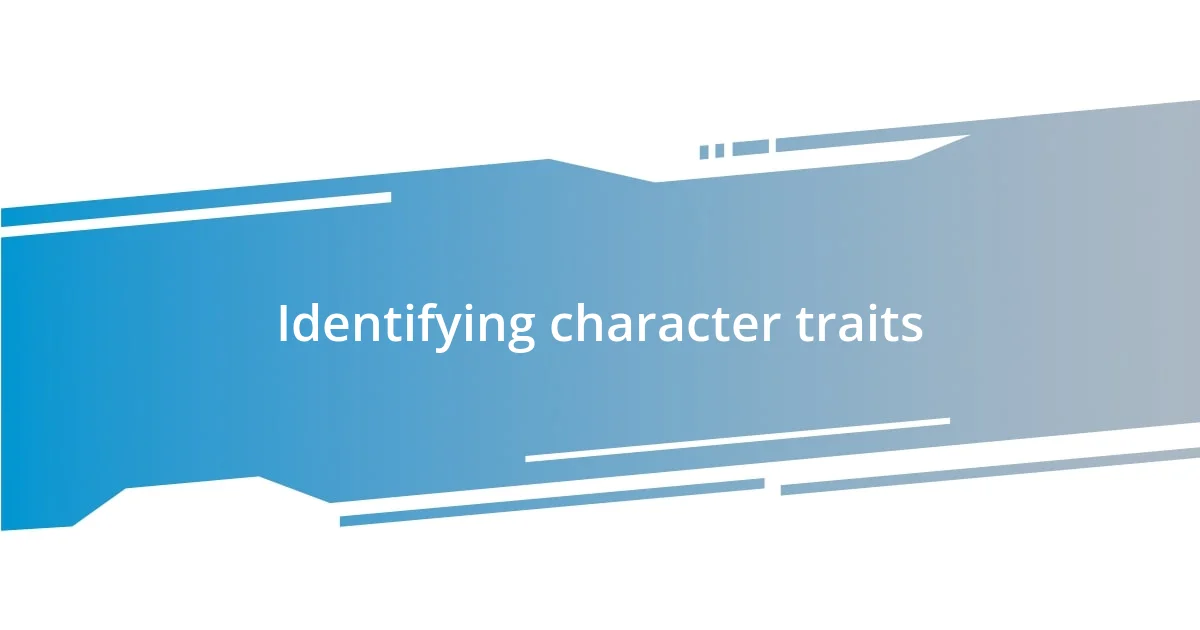
Identifying character traits
When it comes to identifying character traits, I often start by reflecting on the people around me. For example, my best friend has an unwavering sense of loyalty that inspires me every day. Isn’t it fascinating how real-life relationships can inform the traits we ascribe to our characters?
I find that paying attention to a character’s reactions in different scenarios reveals a lot about their traits. In my last project, I put my character through a moral dilemma, and watching how they handled the stress helped me define their resilience and vulnerability. Emotions can be such powerful indicators of depth—how do your characters’ feelings shape their identities?
Observing how characters interact with their environment is also crucial. I once crafted a character who was an artist, and their creativity inherently influenced their worldview. The way they perceived their surroundings told me so much about their traits. Do you see how environment and personality are intertwined? This interplay can lead to some very dynamic character development.
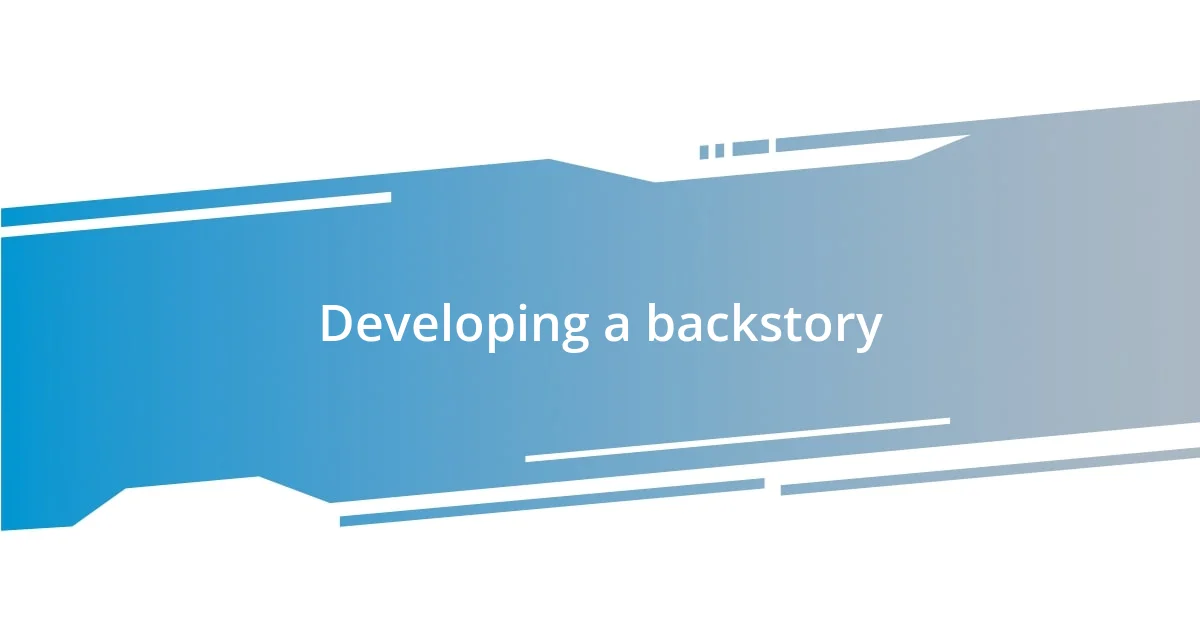
Developing a backstory
When developing a backstory, I often delve into the character’s past experiences to understand their motivations. I remember crafting a character named Iris who grew up in a small, tight-knit community. The values instilled by her family shaped her sense of right and wrong, and reflecting on those early influences helped me to see her internal conflicts more clearly. It’s almost like piecing together a puzzle; each bit of her history unveiled layers of complexity that made her feel real.
- Consider significant life events: What moments shaped your character?
- Explore relationships: How did friendships or rivalries influence them?
- Examine turning points: Was there a defining choice they made?
- Reflect on their environment: How does their hometown or family dynamic affect their worldview?
- Think about their aspirations: What dreams did they hold, and what obstacles did they face?
Through these elements, I find that a character’s past not only adds depth but also enriches their journey in the story.
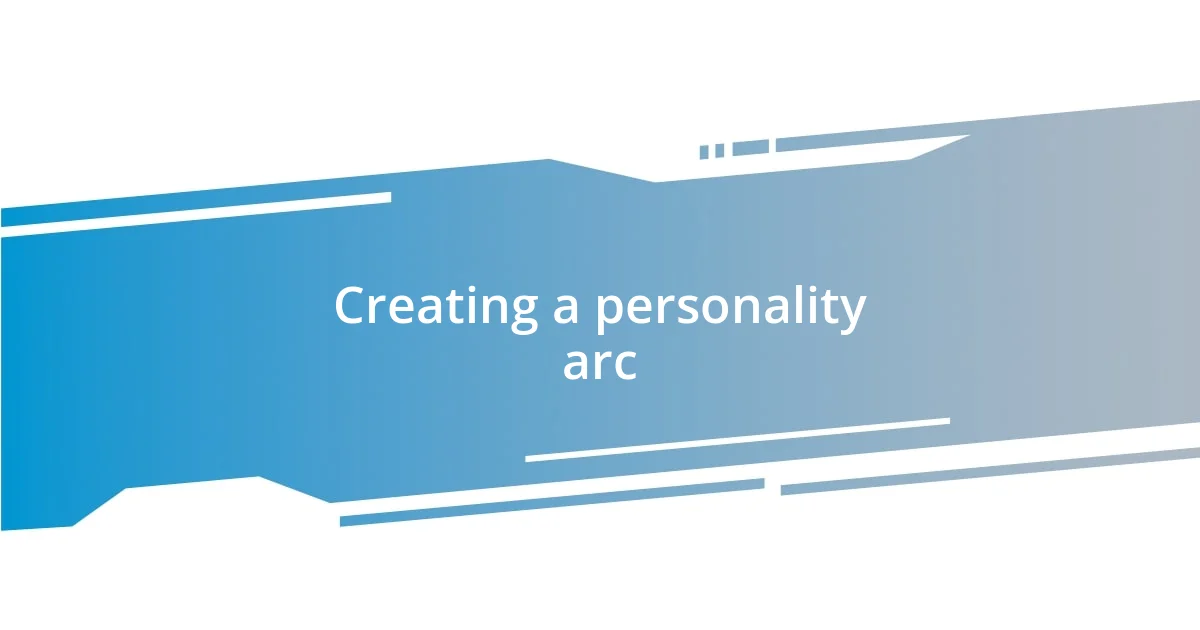
Creating a personality arc
Creating a personality arc is central to my character development process. I’ve noticed that the most compelling arcs often revolve around a central conflict or challenge that forces the character to evolve. For instance, I recently worked on a character named Mark who battled self-doubt throughout the story. By putting him in situations that tested his beliefs, I was able to illustrate his growth from insecurity to confidence. Isn’t it remarkable how a character can resonate with us when we witness their transformation?
Sometimes, I find it helpful to establish a clear trajectory for the character’s emotional journey. In creating Lisa, I charted her progression from fear to courage. Each small victory along her path fueled her transformation, showcasing how confronting one’s fears can be both daunting and liberating. Emotions are the heartbeat of a personality arc—how do these emotional transitions influence your character’s journey and their interactions with others?
Another technique I’ve found effective is the incorporation of external influences. For example, Mark’s arc was significantly shaped by his mentor, who challenged him to embrace vulnerability. This dynamic not only deepened Mark’s personality but also added complexity to his relationships. The supporting characters can often drive the main character’s evolution—who or what influences your characters to grow or change?
| Personality Arc Elements | Example from My Character Development |
|---|---|
| Character Conflict | Mark’s fight with self-doubt |
| Emotional Trajectory | Lisa’s journey from fear to courage |
| External Influences | Mark’s mentor guiding his evolution |
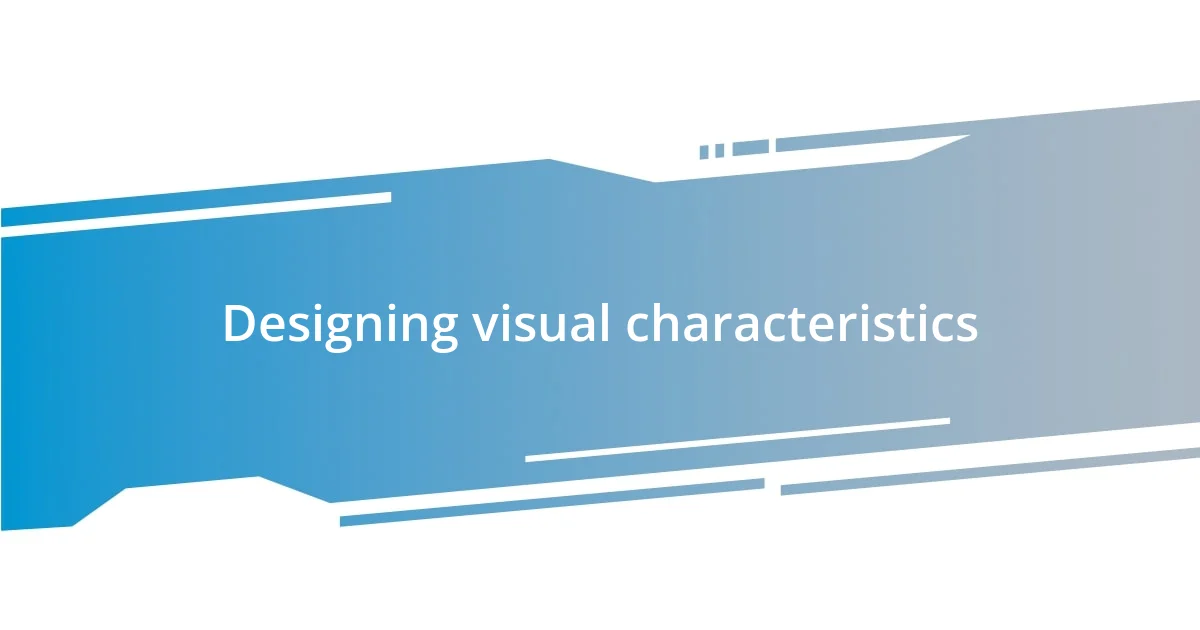
Designing visual characteristics
Designing visual characteristics is an integral part of character development that brings them to life in a vivid way. I often start with broader attributes—like age, gender, and ethnicity—but then dive deeper into unique aspects that make my character stand out. For instance, with Iris, I wanted her quiet strength to be reflected in her appearance. I envisioned her with a striking birthmark on her cheek that hinted at her individuality and told a story of her own, inviting curiosity from those she meets.
As I forge ahead, I consider how a character’s clothes can also convey their personality. When I crafted Mark, I chose a rugged style that mirrored his internal battles. The worn, oversized flannel shirts and scuffed boots told a story of resilience and comfort, characteristics he clung to during moments of doubt. Isn’t it interesting how fashion can be a window into a character’s psyche? When character design aligns with their emotional state, it creates a cohesive narrative that resonates with readers.
Facial expressions and body language are also vital components. I recall a moment when I decided that Lisa would have a tendency to look down when she felt insecure. This small visual cue became a silent yet powerful reflection of her character arc. I’ve found that these subtle traits can evoke empathy and allow readers to connect with a character’s emotions on a deeper level. What visual traits do you think best express your character’s journey?
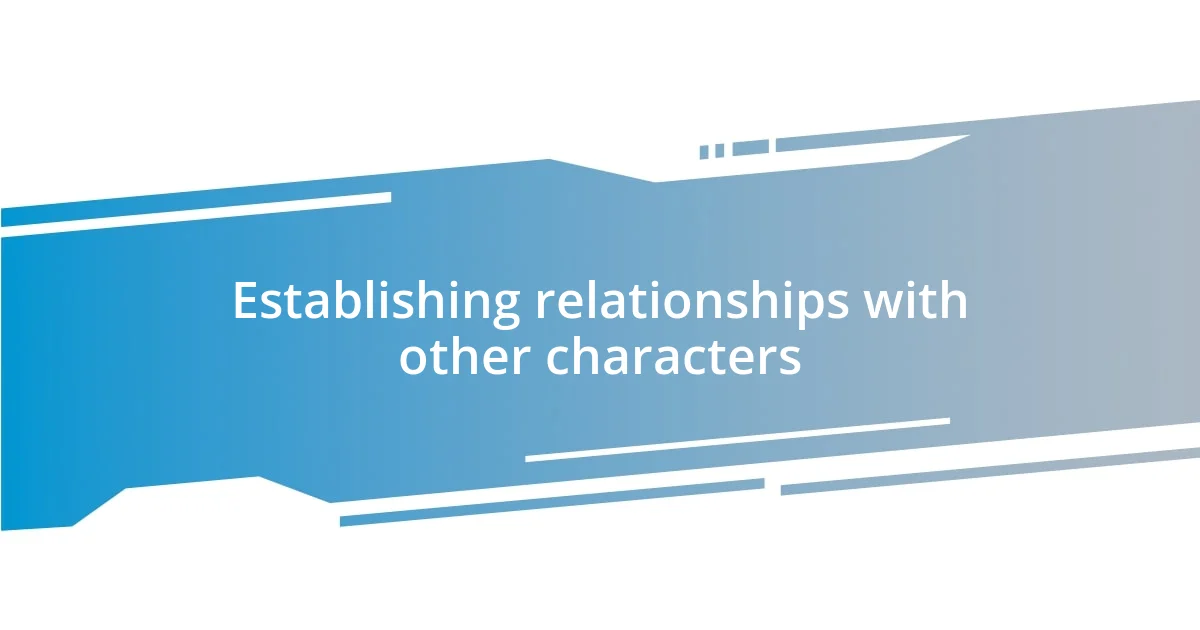
Establishing relationships with other characters
Establishing relationships with other characters is crucial for adding depth to the narrative. I vividly remember crafting the bond between Mark and his mentor. Their relationship was not just a guiding force; it was a source of tension, frustration, and ultimately growth. Watching their dynamic unfold showed me how mentorship can be a dance of influence and resistance, creating a rich tapestry of emotions that captivates the reader.
Conversing with my characters often reveals unexpected connections. For instance, when I explored the friendship between Lisa and her childhood pal, I discovered layers of shared vulnerability. Their dialogues became a safe space for each to voice fears and dreams, thus enriching their arcs. Isn’t it fascinating how friendships can evolve through shared adversity? This interplay made both characters more relatable, as it highlighted their human experiences and struggles.
Finally, I find that romantic relationships, if crafted carefully, can elevate a character’s journey significantly. In my latest work, I introduced a romantic interest for Mark that reflected his emotional growth. Instead of a traditional love story, their relationship grew from mutual respect and understanding. Watching them break down barriers opened new avenues for both characters, showing that love can be a powerful catalyst for change. Have you ever noticed how a romance in storytelling can illuminate a character’s inner conflicts? This dynamic certainly shaped my narrative, creating a sense of authenticity and engagement.
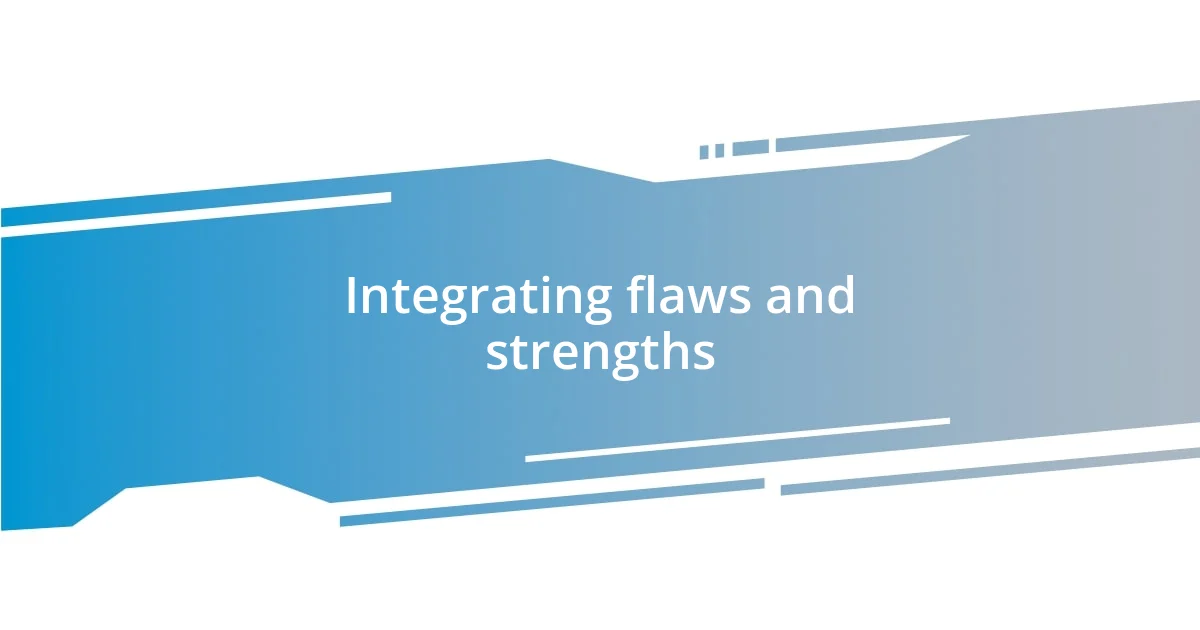
Integrating flaws and strengths
Integrating flaws and strengths in character crafting is like weaving a rich tapestry; each thread contributes to a larger picture. I remember when I developed Sarah, a brilliant scientist who struggles with imposter syndrome. Her moments of self-doubt juxtaposed against her genius illuminate her journey. This dynamic not only makes her relatable but also highlights the tension between her achievements and her insecurities. Can you see how intertwining these attributes creates a more complex character?
I’ve found that crafting characters with both flaws and strengths allows them to resonate on a personal level. Take Jake, for example; his fierce loyalty often leads him to clash with friends when they stray from his moral compass. Instead of making him simply a “good guy,” this conflict paints a vivid portrait of loyalty’s complexities. I noticed that readers connected deeply with his struggles, often reflecting their own dilemmas in his choices. Isn’t it fascinating how our characters can mirror the intricate dance of human emotion?
Moreover, flaws don’t just serve as obstacles; they also provide fertile ground for growth. When I created Emily, her struggle with anxiety became a catalyst for her personal development. Her journey from a shy introvert to a confident public speaker was rich with challenges. I shared her fears, and as she bravely navigated them, I felt readers rooting for her. How often do we recognize our vulnerabilities as stepping stones to strength? This interplay of flaws and strengths can lead to a powerful character evolution that feels authentic and engaging.

Refining the character’s dialogue
Refining dialogue is an art that profoundly shapes character development. When I was piecing together my character Alex, I realized that his conversations had to embody his sharp wit and guarded nature. One afternoon, while drafting, I found myself speaking his lines out loud. Listening to the rhythm and punch in his words helped me capture the essence of his personality. Have you ever noticed how reading dialogue aloud can instantly reveal whether it feels authentic?
In another instance, I focused on using dialogue to highlight emotional tensions. During a heated exchange between two characters, I made sure that their differing viewpoints clashed through short, rapid-fire sentences. This method not only created an electric atmosphere but also exposed deeper vulnerabilities. Reflecting on that scene, I felt a surge of excitement; the words ignited a visceral response in me. Don’t you think that the flow of a conversation can echo the inner turmoil the characters are experiencing?
Additionally, I find it essential to consider the subtext in dialogue. When I constructed the relationship between Mia and her father, their surface conversations were polite yet frigid. However, beneath the surface, I infused subtle hints of resentment and longing. This duality added layers to their interactions that felt both realistic and relatable. How often do we disguise our true feelings in everyday conversations? That realization made their relationship feel more genuine, enhancing not just their connection but the overall narrative.
